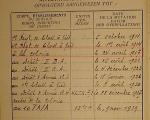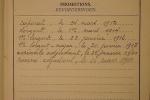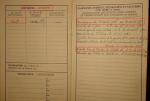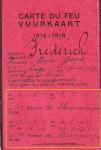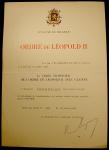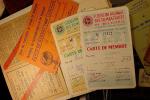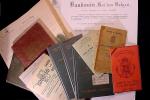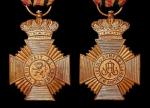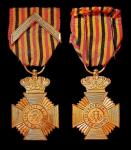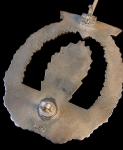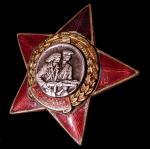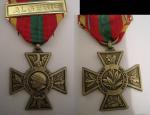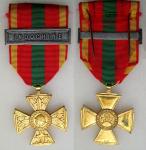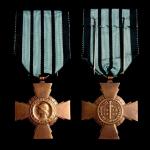
Tim B
Past Contributor-
Posts
2,234 -
Joined
-
Last visited
-
Days Won
2
Content Type
Profiles
Forums
Blogs
Gallery
Events
Store
Everything posted by Tim B
-
Here's his "history of assignments" and maybe this will help identify where and when he was on the front or reassigned. I circled one entry that appears to say in the colonies. Overseas assignment? It might also show if he got out and re-entered the service. Thoughts? Tim
-
-
Okay, no answers on the last questions, let's try a couple more. Here's a page out of the Livret Militaire that shows the member's various citations. You can see it has more entries than what is shown on the Carte Due Feu. Could be just a case of "when" the document came out and what medals had been authorized at that point. I do see the book lists the Yser award as the "Medaille", where the Fire Card listed it as the "Croix". A few more questions (of course ): 1) Again, on the left side they show the "Chevrons" authorized. Not sure exactly what this refers to. Translating online: "Luit" comes up as shine or shown...??? 2) On the right, under the Campaign, Combat, Decoration Cititation section; What is the top entry referring to? Appears to be a unit award to the 4th Regiment Chasseurs? 3) The seventh entry refers to the Leopold II medal, awarded for long service. What grade is it? Gold seems to the logical choice, but I can't tell. Those are the main questions but, some minor questions for clairification. 4) What exactly is the Livret Militaire used for? I notice it lists some of the member's awards but, not all. Was there a cut-off date for recording in this book? I believe the member joined the service in October, 1911 and eventually retired, though I am not sure exactly when at this point. He was awarded the Military Decoration, 2nd Class on 5 January 1924 for service, but at this point he would have had 13 years service and the 2nd class award is supposed to be awarded for 10 years service. Two more years and he should have also received the Military Decoration 1st Class (w/chevron) for 15 years service as an NCO, though there is no record of him receiving this level award. I assume he remained in the service but, he may have got out and later came back in and that may explain the extra three years. Then on November 27th, 1926, he was awarded the Medaille of the Order of Leopold II for long service. Not sure what grade (bronze/silver/gold) but, assume it's the gold level as he was already a Sergeant Major. Wikipedia states the following: Gold Medal: Awarded after 20 years of meritorious service to a non-commissioned officer (9 years for non-commissioned officers member of the flying personnel), and after 25 years of service for a private or corporal; Silver Medal: Awarded after 20 years of meritorious service for a private or corporal. They don't discuss the bronze level. Finally, he was awarded the Order of Leopold II, Knights Class in April 1937. This would place his service around 25 1/2 years if I did my math correctly. However, again, Wikipedia lists the following: Knight: Awarded after 13 years of meritorious service to a commissioned officer, after 30 years of meritorious service for a non-commissioned officer (13 years for non-commissioned officers member of the flying personnel), and after 40 years of service for a private or corporal; And, we know he was awarded the Officer's grade of the Leopold II in July, 1963 as shown in the earlier citation. I am missing something here on the time requirements for these Leopold II awards, as it appears he was awarded some of these long service awards early or later than expected. 5) So, what do you guys familiar with the Belgian award system think here? I know, lot's of questions and I still have more. Thanks again, but I figure by asking, I'm not alone in learning something new here. Tim
-
While we're on the Fire Card, here's the right side and it brings up more questions. Here, we see number of chevrons on top, though I can't make out what it says. And, the basic medals awarded during the war are listed that he was entitled to. I have to ask, 1) Why isn't the Croix Du Feu (Fire Cross) listed here? 2) How complete is this listing supposed to be? I ask as looking in the man's military booklet, there are more awards listed there. Tim :cheers:
-
A center section close-up just for show. Got to love that mustache!! Bet he changed it after 1933. :whistle:
-
Thought I better add a closer sharper PIC so everyone can see what I am talking about. Circled in yellow is the assignment section I am asking the above questions on. I don't see any areas for additional assignments/comments, but I think he may have transferred after 1917. More on that later. Tim
-
Hello Hendrik! Thank you and I figured it had to be this but the translation I kept getting for swords was "épées", so I was confused by it. Guess those online translations have limits! Thank you again and on to the next question... Below, is the man's Carte Du Feu. On the left, I see several entries that show periods of assignment (I assume time at the front) and what regiments he was assigned to during those times. My question revolves around the different entries. 1) Why would he have multiple listings for the same regiment assignment during various time frames if he remained in the same unit? 2) Was it done this way to identify how many bars he would be entitled to? 3) I only see entries up to August 1917, so if he was in from the start, I read that to mean he rated five silver (or 1 gold) bar on the Campaign Medal?
-
Okay, first up and hopefully an easy question; What does the term "AVEC GLAIVES" mean on the Leopold II certificate? I had assumed either crossed swords or possibly palms, but the translation does not cross to anything I can see. This Officer's Grade Leopold II Order was presented in July 1963. I know he was a WWI veteran and had previously been issued both the Leopold II Medal as well as the Knights grade of the Leopold Order. Tim
-
Another quick shot. It's a nice family document group overall, though I am really interested in the service member only. Tim
-
Hey guys, I finally got around to photographing some of the document grouping to a Belgian Sergeant Major in the 4th Regiment Chasseurs à Pied (Light Infantry). Obviously, I have several questions and would greatly appreciate any help here. I'll post some of the documents as questions arise, vice posting all the documents at once and then trying to go back and forth. Honestly, the grouping is not just the service member's but, I also have documents for the wife and two sons. A lot of the paperwork is post-war stuff like marriage certificates, identity and benefit cards, pension booklet, passports, etc. To get an idea what I am up against, I'll post a couple of group PIC's. So not to bog down the process, I'll concentrate on just the war service record. I am mostly interested in the entries in the member's Military Booklet (Livret Militaire) and on his Fire Card (Carte Du Feu). Thanks in advance! Tim
-
Belgium Decoration Militaire Belgium
Tim B replied to g_deploige's topic in Northern European & Baltic States
I had a difficult time trying to cross it over using Guy's site matrix and finally asked Guy if this might be a totally different "type" from the various examples he shows and ... it is. I'm guessing, based on the die traits, it might fall between the "Types 6 & 7", but it's anyone's guess as there are probably several makers of these. Tim -
Belgium Decoration Militaire Belgium
Tim B replied to g_deploige's topic in Northern European & Baltic States
Here's an interesting addition. I needed a 1st Class award for the collection and got lucky getting this one. Tim -
Come to think of it, this revelation also casts doubt upon the unmarked Deumer Minesweepers with this same setup, since now it's possible they could be by G.W.L. or supplied to G.W.L. by Deumer. A close relationship between the Wegerhoffs and the Deumers seems likely. Best regards, ---Norm Hi Norm, There are minesweepers (with the vertical needle pin) made by Deumer that are marked (L/11). I think that's why the concensus of the unmarked ones are also Deumer. The die characteristics front and back are consistent on their minesweepers as well. Best Regards, Tim Here's a marked tombak piece with the L/11; note it has a replaced catched.
-
Albania Order of the Partisan Star
Tim B replied to Bob's topic in Southern European & Balkan States
Here's a question; Is there a difference between the stars that have the small triangle on the reverse tips and those that do not? The below pictured star on the left is mine from above but, the one on the right does not have these small marks on any of the tips, and comparing it to the above Soviet "gold" star, this one is not impressed like that one either. Different producer or timeframe of manufacture? Thanks, Tim -
Bulgaria Bulgarian Partisan Badge
Tim B replied to Stogieman's topic in Central & Eastern European States
:love: Rick, that's a beauty! I assume this badge only comes in this one verson, unlike the partisan stars from Albania and Yugoslavia? Tim -
Bulgaria Bulgarian Partisan Badge
Tim B replied to Stogieman's topic in Central & Eastern European States
Nice Doc Rick! Yes, I have only seen a couple of these and both had some damage to the top star point. Too bad on your enamel damage as that piece is in exceptional condition otherwise. Tim :beer: -
Bulgaria Bulgarian Partisan Badge
Tim B replied to Stogieman's topic in Central & Eastern European States
Not as minty as Rick's (Stogieman), but really a powerful design. Just how rare/scarce are these? Tim -
Bulgaria Bulgarian Partisan Badge
Tim B replied to Stogieman's topic in Central & Eastern European States
Finally got around to taking some PIC's. Worn but, still pretty decent shape despite the top arm having the enamel replaced. Tim -
So, anybody have any ideas why the two different designs and if one came before the other? Tim
-
-
Hi Prosper! Yes, I was reading that in another old thread, and see where it came into being about the same timeframe the WWI pieces were developed. Though, as someone (Guy?) pointed out, probably only a handful were ever needed or purchased at that stage, as most of the youngest vets of that war would have been in their 70's by the time the medal was authorized. I'll have to go an check what style was used on that particular example, but hard to say if that was the only style used. Here are two more later examples (not mine) and you can see both styles are represented. I cannot verify if the medals or bars are authentic or not, and whether or not these are currently being restruck. Tim :cheers:
-
Hi Rob, Certainly, as soon as I get it and get some PIC's taken. I too am curious as to the marking on this one. Arthur Bertrand, not so sure but, I am using a site reference and he may have used more than one, I just have to wait and see what I got in hand first. Have you tried this link yet? http://www.925-1000.com/index.html http://www.925-1000.com/Ffrench_marks.html Tim :cheers:
-
Perhaps someone would fall for these if they had a later 1944 or '45 date but, they are dated 1939 when quality would have been "at least expected" better. Tim
-


